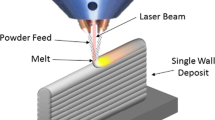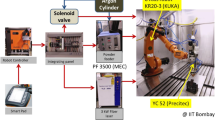Abstract
This paper presents a novel application of a three-dimensional smoothed particle hydrodynamics model to simulate directed energy deposition (DED) additive manufacturing processes. A proposed workflow comprises a random powder generator to introduce individual powder particles into the SPH core simulation. The DED workflow simulation is successfully demonstrated for two real DED setups with significantly difference of individual powder/melt-pool size ratios and different materials. The simulation results are in good agreement with experimental data in terms of geometrical dimensions of deposited material and melt-pool surface temperature. Detail analyses on the results revealed transient internal characteristics of the melt-pool which otherwise nearly impossible to be observed from experimental data. These include the concave shape of the melt-pool surface, bifurcations and circulations of metal liquid flow, and spatial–temporal temperature distributions in the melt-pool which also vary with respect to scan parameters. These findings could provide better understanding on the DED processes that are difficult to measure and help achieve better quality of the printed products.



















Similar content being viewed by others
Availability of data and material
The data that support the findings of this study are available from the corresponding author, M.H. Dao, upon reasonable request.
Code availability
The code that supports the findings of this study is available from the corresponding author, M.H. Dao, upon reasonable request.
References
Daas A, Moridi A (2019) State of the art in directed energy deposition: from additive manufacturing to materials design. Coatings, 9: 418. https://doi.org/10.3390/coatings9070418
Lee J, Park HJ, Chai S, Kim GR, Yong H, Bae SJ, Kwon D (1966) (2021) Review on quality control methods in metal additive manufacturing. Appl Sci 2021:11. https://doi.org/10.3390/app11041966
Corbin DJ, Nassar AR, Reutzel EW, Beese AM, Kistler NA (2017) Effect of directed energy deposition processing parameters on laser deposited Inconel® 718: External morphology. J Laser Appl, 29:022001. https://doi.org/10.2351/1.4977476
Shah K, Salman A, Pinkerton AJ, Li L (2009) The significance of melt pool variables in laser direct deposition of functionally graded aerospace alloys. ICALEO 2009, 569. https://doi.org/10.2351/1.5061613
Mazzucato F, Aversa A, Doglione R, Biamino S, Valente A, Lombardi M (2019) Influence of process parameters and deposition strategy on laser metal deposition of 316L powder. Metals, 9:1160. https://doi.org/10.3390/met9111160
Boddu MR, Musti S, Landers RG, Agarwal S, Liou FW (2001) Empirical modeling and vision based control for the laser metal deposition process, in: Twelfth Annual Solid Freeform Fabrication Symposium, Austin, Texas, August 6–8, 2001, pp. 452–459.
Miedzinski M (2017) Materials for additive manufacturing by direct energy deposition. master’s thesis in materials engineering, Department of Materials and Manufacturing Technology, Chalmers University of Technology
He X, Mazumder J (2006) Modeling of geometry and temperature during direct metal deposition. ICALEO 2006. https://doi.org/10.2351/1.5060806
Pinkerton AJ, Moat R, Shah K, Li L, Preuss M, Withers PJ (2017) A verified model of laser direct metal deposition using an analytical enthalpy balance method. In Proceedings of the International Congress on Applications of Lasers & Electro-Optics, Orlando, FL, USA.
Wen S, Shin YC (2010) Modeling of transport phenomena during the coaxial laser direct deposition process. J Appl Phys 108:044908. https://doi.org/10.1063/1.3474655]
Wen S, Shin YC (2011) Comprehensive predictive modeling and parametric analysis of multitrack direct laser deposition processes. J Laser Appl 23:022003. https://doi.org/10.2351/1.3567962
Morville S, Carin M, Peyre P, Gharbi M, Carron D, Le Masson P, Fabbro R (2012) 2D longitudinal modeling of heat transfer and fluid flow during multi-layered direct laser metal deposition process. J Laser Appl, 24:032008. https://doi.org/10.2351/1.4726445
Zhao Z, Zhu Q, Yan J (2021) A thermal multi-phase flow model for directed energy deposition processes via a moving signed distance function. Comput Methods Appl Mech Engrg 373. https://doi.org/10.1016/j.cma.2020.113518
Amine T, Newkirk JW, Liou F (2014) Investigation of effect of process parameters on multilayer builds by direct metal deposition. Appl Therm Eng 73:500–511
Du L, Gu D, Dai D, Shi Q, Ma C, Xia M (2018) Relation of thermal behavior and microstructure evolution during multi-track laser melting deposition of Ni-based material. Opt Laser Technol 108:207–217
Caiazzo F, Alfieri V (2019) Simulation of laser-assisted directed energy deposition of aluminium powder: prediction of geometry and temperature evolution. Materials, 12:2100. https://doi.org/10.3390/ma12132100
Huang Y, Khamesee MB, Toyserkani E (2019) A new physics-based model for laser directed energy deposition (powder-fed additive manufacturing): from single-track to multi-track and multi-layer. Opt Laser Technol 2019(109):584–599
Heigel JC, Michaleris P, Reutzel EW (2015) Thermo-mechanical model development and validation of directed energy deposition additive manufacturing of Ti-6Al-4V. Addit Manuf 5:9–19
Kovaleva I, Kovalev O, Zaitsev A, Smurov I (2013) Numerical simulation and comparison of powder jet profiles for different types of coaxial nozzles in direct material deposition. Phys Procedia 41:870–872
Thakar Y, Pan H, Liou F (2004) Analysis of the powder flow characteristics for the direct laser deposition process. ICALEO 2004, 1703. https://doi.org/10.2351/1.5060227
Lin J (2000) Laser attenuation of the focused powder streams in coaxial laser cladding. J Laser Appl 12(1):28–33
He W, Zhang L, Hilton P (2009) Modelling and validation of a direct metal deposition nozzle. ICALEO 2009, 589. https://doi.org/10.2351/1.5061616
Zeng Q, Tian Y, Xu Z, Qin Y (2018) Simulation of thermal behaviours and powder flow for direct laser metal deposition process. MATEC Web of Conferences 190, 02001. https://doi.org/10.1051/matecconf/201819002001
Han L, Phatak KM, Liou FW (2004) Modeling of laser cladding with powder injection. Metall Mater Trans B 35:1139–1150. https://doi.org/10.1007/s11663-004-0070-0
Pinkerton AJ (2015) Advances in the modeling of laser direct metal deposition. J Laser Appl, 27:S15001. https://doi.org/10.2351/1.4815992
Guan X, Zhao YF (2020) Modeling of the laser powder–based directed energy deposition - a review. Int J Adv Manuf Technol 107:1959–1982
Wessels H, Bode T, Weißenfels C, Wriggers P, Zohdi TI (2018) Investigation of heat source modeling for selective laser melting. Comput Mech. https://doi.org/10.1007/s00466-018-1631-4
Anedaf T., Abbès B., Abbès F., and Li Y.M. (2018). 2D modeling of direct laser metal deposition process using a finite particle method. AIP Conference Proceedings 1960, 140002. https://doi.org/10.1063/1.5034994
Dao MH, Lou J (2021) Simulations of laser assisted additive manufacturing by smoothed particle hydrodynamics. Comput. Methods Appl Mech Engrg, 373:113491
Weirather J, Rozov V, Wille M, Schuler P, Seidel C, Adams NA, Zaeh MF (2019) A Smoothed particle hydrodynamics model for laser beam melting of Ni-based alloy 718. Comput Math Appl 78:2377–2394
Russell MA, Souto-Iglesias A, Zohdi TI (2018) Numerical simulation of laser fusion additive manufacturing processes using the SPH method. Comput Methods Appl Mech Engrg 341(2018):163–187
Fürstenau J, Wessels H, Weißenfels C, Wriggers P (2019) Generating virtual process maps of SLM using powder-scale SPH simulations. Comp Part Mech. https://doi.org/10.1007/s40571-019-00296-3
Wessels H, Weisenfels C, Wriggers P (2018) Metal particle fusion analysis for additive manufacturing using the stabilized optimal transportation meshfree method. Comput Methods Appl Mech Engrg 339(2018):91–114
Fan Z, Li B (2019) Meshfree simulations for additive manufacturing process of metals. Integrating Materials and Manufacturing Innovation. https://doi.org/10.1007/s40192-019-00131-w
Song J, Chew Y, Bi G, Yao X, Zhang B, Bai J, Moon SK (2018) Numerical and experimental study of laser aided additive manufacturing for melt-pool profile and grain orientation analysis. Mater Des 137:286–297
Khairallah S, Anderson A (2014) Mesoscopic simulation model of selective laser melting of stainless steel powder. J Mater Process Technol 214(11):2627–2636
Acknowledgements
Numerical simulations are performed on ASPIRE1 (Advanced Supercomputer for Petascale Innovation Research and Enterprise) provided by the National Supercomputing Centre (NSCC) Singapore.
Author information
Authors and Affiliations
Corresponding author
Ethics declarations
Conflict of interest
The authors declare no competing interests.
Additional information
Publisher's Note
Springer Nature remains neutral with regard to jurisdictional claims in published maps and institutional affiliations.
Rights and permissions
About this article
Cite this article
Dao, M.H., Lou, J. Simulations of directed energy deposition additive manufacturing process by smoothed particle hydrodynamics methods. Int J Adv Manuf Technol 120, 4755–4774 (2022). https://doi.org/10.1007/s00170-022-09050-1
Received:
Accepted:
Published:
Issue Date:
DOI: https://doi.org/10.1007/s00170-022-09050-1




